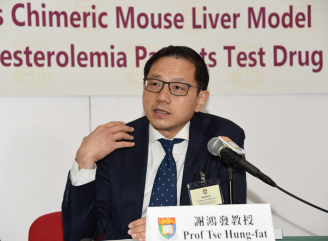Media
HKU Develops Chimeric Mouse Liver Model
Helps Familial Hypercholesterolemia Patients Test Drug Response
20 Apr 2017
Familial hypercholesterolemia (FH) is a hereditary hypercholesterolemic disease, in which the patient has inherited the disease gene from one of the parents. This means even if the patients have standard weight and healthy diet, they will still suffer from the disease. Since FH is not caused by dietary factors, control of the disease is generally more difficult. Most of these patients are not responsive to the traditional statin treatment while some patients even have significant adverse effects. Since 2010, Li Ka Shing Faculty of Medicine of The University of Hong Kong (HKU) uses human urine as cell source, reprogrammes urine cells into induced pluripotent stem cells (iPSCs) and differentiates into liver cells (iHep), using these cells for creation of chimeric mouse model. The research team successfully tested the drug response and confirmed that the PCSK9 antibody was more efficient than the statin treatment for FH patients.
Familial hypercholesterolemia (FH)
Familial hypercholesterolemia is a genetic disorder caused by gene mutations in cholesterol metabolism. FH patients have particularly high levels of low-density lipoprotein cholesterol (LDL-C), making patients stand with high risk of coronary artery disease (CHD). CHD is one of the most common life-threatening heart diseases in Hong Kong. In 2013, 10 people died every day in average due to CHD.
Familial hypercholesterolemia is divided into two types, heterozygous and homozygous FH, depending on the inherited genetics. The former one inherited one disease gene from either parent. The prevalence rate and disease incidence rate are 10 million and 1:500, respectively. The latter one inherited both disease genes from both parents, the disease incidence rate is about 1 in 100 million. However, most people do not know they are FH patients due to lack of the knowledge towards the disease.
Statin is the most widely used drug for treating FH. The principle of statin is to inhibit 3-hydroxy-3-methylglutaryl coenzyme A (HMG-CoA) reductase to reduce liver cholesterol synthesis, increasing low density lipoprotein receptor protein levels in liver cells in and decreasing low density lipoprotein cholesterol (LDL-C) in blood. However, the majority of these patients are not responsive to statin, resulting in ineffectiveness in the reduction of LDL-C in blood. What’s even worse is that some FH patients have serious side effects to statin, such as rhabdomyolysis, causing renal failure. Compared with statin, another new drug, PCSK9 inhibitor, can reduce LDL-C more effectively, and have lower chance of drug resistance. However, PCSK9 inhibitors are expensive and only few patients can bear long-term treatment costs.
Research method
To further explore the effectiveness of new treatments for FH, the research team extracted patient urine cells, reprogrammed the urine cells into induced pluripotent stem cells (iPSCs) and differentiated into liver cells (iHep), the iHeps are then injected into the mouse in vivo, and hence the mouse liver contains patient liver cells. The chimeric mouse model simulates the condition of patients with FH and was used to test the different drug response with statin (simvastatin) and PCSK9 inhibitors by assessing plasma LDL-C levels and endothelial function, as a new therapy for FH.
Research results and significance
Our research team is the first in Hong Kong to develop the use of chimeric stem cell mouse models to test the pharmacological effects of FH drugs in vitro and in vivo. The results confirmed that PCSK9 inhibitors have a higher clinical efficacy than traditional used drug statin in reducing LDL-C and enhancing endothelial function. Our results highlighted the importance of the use of human stem cell-derived liver cells for in vivo models establishment, and provided a model for preclinical drug testing for all types of hereditary liver diseases.
Professor Tse Hung-fat, William M W Mong Professor in Cardiology, Chair Professor of Cardiovascular Medicine, Department of Medicine, Li Ka Shing Faculty of Medicine, HKU says, “Our new animal model can be used for drug testing and as new therapy for FH patient in the near future. With this model, other new therapeutic drugs such as siRNA, microRNA inhibitors and small molecule compounds can be preclinical tested, and we also wish to extend the current model to other hereditary liver diseases such as Wilson's disease.”
About the research team
The study was led by Professor Tse Hung-fat, William M W Mong Professor in Cardiology, Chair Professor of Cardiovascular Medicine, Department of Medicine, Li Ka Shing Faculty of Medicine, HKU, in collaboration with Dr Miguel A Esteban, Guangzhou Institutes of Biomedicine and Health, Chinese Academy of Sciences. This research was funded by Theme-based Research Scheme (T12-705/11), Research Grants Council of Hong Kong.
Please visit the website at http://www.med.hku.hk/news/ for press photos and presentation slides.
Professor Tse Hung-fat, William M W Mong Professor in Cardiology, Chair Professor of Cardiovascular Medicine, Department of Medicine, Li Ka Shing Faculty of Medicine, HKU expects that the new animal model can be used for drug testing and as new therapy for familial hypercholesterolemia patient, and extended to other hereditary liver diseases in the near future.



